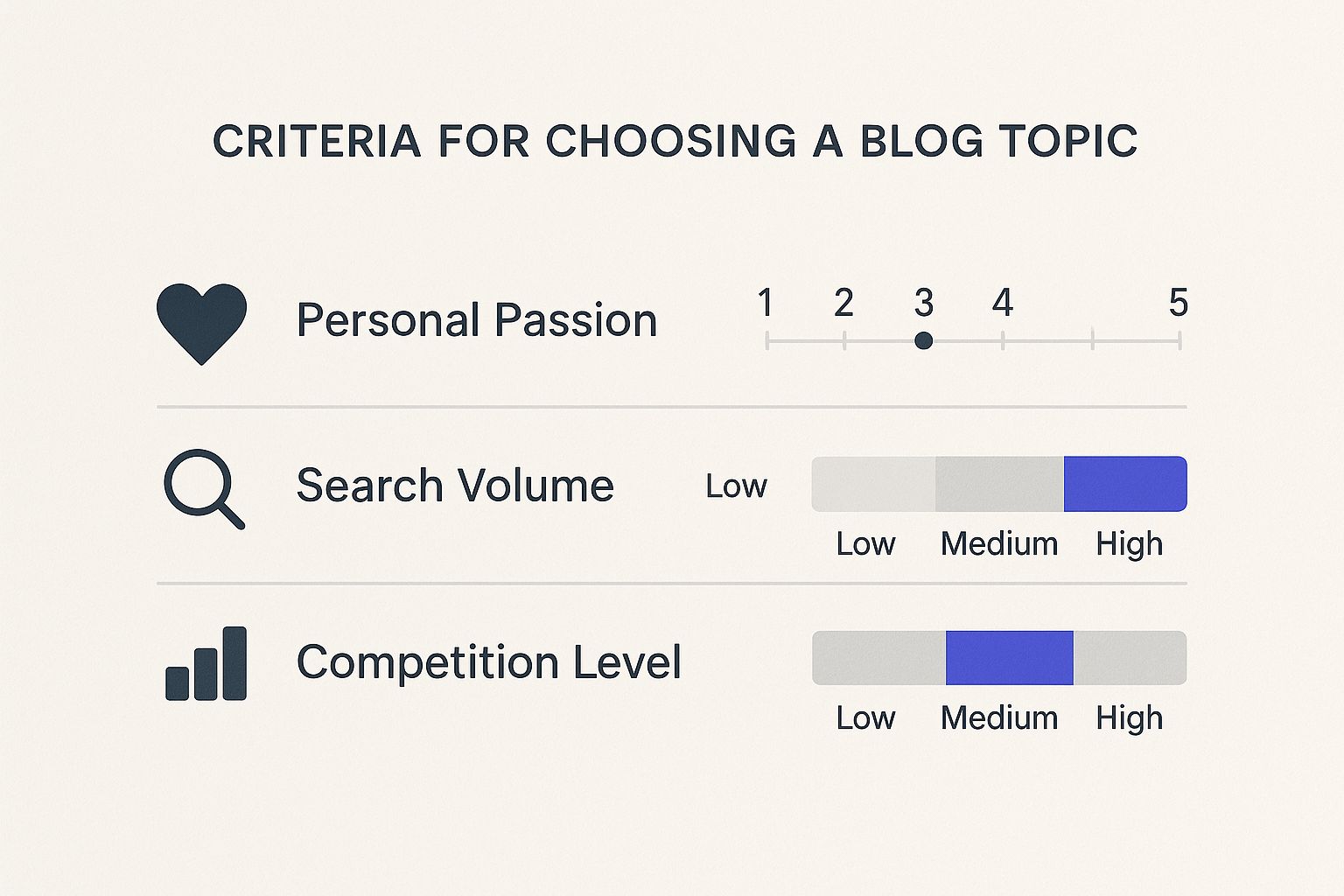Finding Your Place In The Blogging World

Seeing that 7.5 million blog posts go live every day can be a bit intimidating, right? I know, I felt the same way when I first started. It's a jungle out there! That's why finding your own little corner of the internet is so important.
So, how do you cut through the noise? The key is authenticity. Think of it this way: even though there are tons of blogs about, say, gardening, there's only one you. Your personal stories and experiences are what will draw readers in.
Picking the right topic is also huge. Choose something you're genuinely passionate about. Something you can see yourself writing about for years to come. I've seen so many bloggers burn out because they picked a trending topic instead of something they truly loved.
Digging Deeper Into Your Niche
Let's say you're obsessed with vintage cameras. Great! Become the resource for all things vintage cameras. Share your knowledge, repair tips, or even your favorite film stocks. Don't try to be everything to everyone, just focus on your specific area of expertise.
Figuring out your "why" is just as important as the "what." What's driving you to blog? Are you sharing your expertise? Connecting with like-minded people? Maybe you're hoping to start a blog as part of building a business? Knowing your motivation will help you stay focused when things get tough.
Why Authenticity Matters
Coming back to that 7.5 million number – it's a constant reminder to be yourself. More information on these blogging stats can be found here. In a sea of content, your unique perspective is your superpower. Let your personality shine through! Connect with your readers on a personal level. That's what will turn casual readers into dedicated fans. And honestly, that's what will determine whether you're still blogging six months from now or if you end up joining the millions who give up after a few posts.
Turning Ideas Into Posts People Want To Read
Great blog posts begin with a spark – a killer idea. But unearthing those golden nuggets that truly resonate with your audience requires a bit of digging. One of my go-to strategies is scoping out the competition. What are other blogs in your niche talking about? What's trending on social media platforms like Twitter? What questions are people asking in online forums like Reddit? This gives you a real-world sense of what your target audience craves.
You might be interested in: Learn more about content creation for beginners on BlogMaker
Before you pour hours into writing, validate your ideas. I’ve found that simply tossing out potential topics to friends, family, or even my social media followers is a game-changer. This quick pulse check can save you from writing a blog post that misses the mark.

This infographic highlights a crucial trifecta: Personal Passion, Search Volume, and Competition Level. The sweet spot is where your passion intersects with a topic people are searching for, but isn't oversaturated. This might mean niching down within a broader topic – focusing on a specific slice of the pie, so to speak, to avoid going head-to-head with the big players.
I've found that getting specific really helps. For example, instead of writing about "healthy eating," I might focus on "healthy meal prep for busy professionals."
Crafting Compelling Content Outlines
Once you have a validated idea, an outline is your roadmap. But it shouldn't be rigid. Think of it more like a flexible guide. A good outline provides structure but allows room for your writing to breathe and evolve.
I usually start by dividing my topic into key sections using H2 and H3 headings. Under each heading, I jot down the main points I want to cover, often using bullet points for easy scanning. Remember, a blog post isn't an academic paper. Keep the language conversational, ditch the jargon, and prioritize practical value for your reader.
Let’s talk about planning and avoiding common beginner mistakes. I've put together a checklist that has helped me immensely:
Blog Post Planning Checklist vs. Common Beginner Mistakes
| Planning Step | What to Do | Common Mistake | Why It Matters |
|---|---|---|---|
| Idea Generation | Research trends, competitor blogs, audience needs | Writing about what you want | Relevance is key. Readers want content that addresses their interests and needs. |
| Idea Validation | Test your idea with your target audience | Assuming your idea is a winner without checking | Validation saves time and ensures you're creating content people actually want. |
| Outline Creation | Structure your post with headings and subheadings | Skipping the outline altogether | A clear outline provides focus and prevents rambling. |
| Angle Selection | Find a unique perspective on your chosen topic | Covering generic information | A fresh angle makes your content stand out in a crowded online space. |
This table summarizes the key steps for effective planning, and I refer to it often. It's easy to get caught up in the excitement of a new idea and skip these crucial steps, but trust me, taking the time to plan makes all the difference.
Choosing the Right Angle
Even familiar topics can feel new with the right angle. Let's say you're writing about "how to write a blog post for beginners" (our keyword!). Instead of retreading well-worn territory, consider focusing on a specific aspect, like "Crafting Compelling Headlines" or "Optimizing Blog Posts for SEO." This targeted approach helps you cut through the noise.
Another tip I've learned is to weave in personal stories and real-world examples. This not only makes your writing more engaging but also builds trust. Sharing your own struggles and successes makes you relatable and helps forge a connection with your readers.
Writing Headlines That Stop The Scroll
Let's be honest, your headline is everything. It's the first (and sometimes only) impression you make on a potential reader. Think of it as the digital equivalent of a storefront window display – a weak headline, and no one bothers to come inside, no matter how amazing your products (or blog post) are. I've been there, trust me – pouring my heart into a piece only to have it flop because the headline just wasn't catchy enough.
So, what's the secret sauce to writing headlines that actually make people stop scrolling and click? It's a mix of understanding what makes people tick and knowing a few proven tricks of the trade. Think less shouting into the void, and more whispering something intriguing.
Understanding the Psychology of Clicks
Think about it – what makes you click on a headline? Usually, it's something that piques your curiosity, promises a solution to a problem you have, or offers a juicy piece of information you just can't resist. These are the psychological triggers that underpin effective headlines. The best bloggers know this intuitively. They tap into those underlying emotions, create curiosity gaps, and clearly show the reader what's in it for them.
For example, which headline are you more likely to click: "Tips for Better Writing" or "5 Secrets to Writing Emails That Get Opened Every Time"? The second one, right? It’s specific, addresses a common problem, and promises actionable solutions.
Proven Headline Formulas That Work
While there's no magic bullet for crafting the perfect headline, some formulas consistently outperform others. Numbered lists (like "7 Ways to…"), how-to guides (such as "How to Write a Blog Post for Beginners"), and questions ("Are You Making These Common Blogging Mistakes?") are all great starting points. Sprinkling in a few power words like "secrets," "ultimate," or "essential" can also boost engagement. Just remember to use them genuinely and avoid clickbait – no one likes feeling tricked.
Data can be your best friend when it comes to headline writing. For example, headlines between 6-13 words tend to perform better, and odd numbers seem to have a slight edge over even numbers. These small tweaks can make a huge difference in how easily people find your content. In fact, optimizing your headlines can boost your search engine rankings by as much as 434%. Want to dive deeper into headline strategies? Check out this resource: OptinMonster Blogging Statistics.
Testing and Refining Your Headlines
Even with a tried-and-true formula, testing is essential. Try writing a few different headlines for each post and see which one performs best. BlogMaker’s analytics dashboard is perfect for this – you can track click-through rates and get a clear picture of what resonates with your audience. This data-driven approach takes the guesswork out of headline writing and helps you hone your skills over time.
Remember, writing killer headlines is a muscle you build with practice. Don't be afraid to experiment, analyze your results, and keep tweaking your approach. The more you practice, the better you'll become at writing headlines that grab attention and drive traffic to your blog.
Creating Content That Hooks and Holds Readers
The difference between amateur and professional blog content isn't some magical secret sauce, it's understanding how people actually read online. I remember when I first started, I felt like my writing just wasn't grabbing people the way other bloggers seemed to. It turned out it wasn't what I was saying, but how I was saying it. So, let's dive into how to keep your readers hooked from the very first sentence.
Hooking Your Readers From The Start
Think of your opening line like a fishing lure – it needs to be irresistible. Here are a few tried-and-true methods I use:
The Problem/Solution Hook: Start by pinpointing a pain point your reader has, then immediately hint at the solution you're offering. For example, "Tired of your blog posts getting lost in the internet void? This guide shows you how to write content that ranks high and attracts readers."
The Intriguing Question Hook: Ask a question that sparks curiosity. Something like, "What if writing viral blog posts was as simple as following a formula?"
The Story Hook: Kick things off with a short, relevant anecdote. This works especially well for beginner guides, where you can share your own blogging journey.
Structuring Your Content for Easy Consumption
Nobody wants to wade through walls of text online. Think about it, the average reader spends about 52 seconds on a blog post, with average time on page hovering between 3 to 5 minutes. Discover more insights into blogging statistics. So, make every second count by structuring your content for skimmers:
Use Headings and Subheadings (H2s and H3s): Break your content into bite-sized chunks, just like this guide.
Keep Paragraphs Short: Two to four sentences is the sweet spot.
Incorporate Bullet Points and Lists: These are your secret weapons for highlighting key takeaways and outlining steps.
Add Visuals: Images, infographics, and videos add visual interest and break up the text. Tools like BlogMaker's DesignStudio make adding visuals super easy.
Let's talk about content length and how it relates to engagement. I've put together a table summarizing some key metrics. It really illustrates how finding the right balance can make a big difference.
Content Length vs. Engagement Metrics
| Word Count Range | Average Time on Page | Bounce Rate | Social Shares | SEO Performance |
|---|---|---|---|---|
| <500 | 1:30 | 60% | Low | Low |
| 500 - 1000 | 2:30 | 45% | Medium | Medium |
| 1000 - 2000 | 4:00 | 30% | High | High |
| >2000 | 5:00+ | 20% | High | High |
As you can see, longer posts tend to perform better, but it's not just about hitting a certain word count. Quality content that keeps readers engaged is key. Don't fluff it up just to hit 2000 words!
Mastering The Art of Conversational Writing
One of the biggest newbie mistakes? Writing too formally. You're trying to connect with your readers, so write like you're talking to a friend:
Use Contractions: "Can't" instead of "cannot," "you're" instead of "you are," and so on. It makes your writing feel more natural.
Embrace Personal Anecdotes: Sharing your own experiences helps readers relate to you and builds trust. Just make sure it serves the reader and isn't just about you.
Use Analogies and Examples: They help clarify complex ideas and keep your writing interesting. For instance, when explaining keyword research, you could compare it to finding the right radio frequency to reach your target audience.

By following these tips, you'll transform your blog posts from dry and robotic to engaging and memorable. Your readers will appreciate the clear structure and friendly tone, making them much more likely to stick around, share your content, and become loyal followers. Remember, the goal is to create content that informs and connects.
SEO That Actually Works For Real Bloggers
Forget all the complicated SEO tricks you hear about. When you’re just starting out, the best SEO strategy is simple: write helpful content that answers real questions. I remember when I started; I was drowning in technical terms like keyword density, backlinks, and meta descriptions. It was overwhelming! Eventually, I realized the bloggers who were killing it weren't playing SEO games. They were focused on creating content their readers actually wanted.
Keyword Research Without The Fancy Tools
You don't need to shell out for expensive keyword research software. Just think like your reader. What would you type into Google if you were looking for information on your topic? Let's say I'm writing about "how to write a blog post for beginners." I'd also consider phrases like "blogging for beginners," "how to start a blog," or "blog post writing tips."
Google itself can be your best free tool. Start typing your topic into the search bar, and watch the autosuggest feature work its magic. This shows you exactly what people are searching for right now.
Here's what that looks like in action:
See how Google suggests related searches and shows "People also ask" questions? That's pure gold for understanding what your audience wants to know.
Natural Keyword Integration
Once you have a few target keywords, don't go crazy stuffing them into every other word. Keyword stuffing is a fast track to getting penalized by Google. Just use your keywords naturally, like you would in a normal conversation. You wouldn’t awkwardly repeat the same phrase over and over when talking to a friend, right? The same applies to your blog posts. Aim for a keyword density of around 1-2% – that’s about one or two times for every 100 words, blended smoothly into your writing.
On-Page Optimization Made Easy
On-page optimization is simply about making your content easy to understand, for both readers and search engines. Here are a few key things to keep in mind:
Using descriptive header tags (H2s and H3s): These break your content into digestible chunks and make it easy for readers to skim. Plus, they give you more places to naturally use your keywords.
Writing compelling meta descriptions: This is the short blurb that shows up under your title in search results. Think of it as your blog post’s elevator pitch – make it enticing and relevant to your keyword.
Using internal and external links: Linking to other helpful content, both on your own blog and from other reputable sources, shows Google that your content is well-researched. It also provides more value for your readers. For more tips, check out our guide on how to optimize blog posts for SEO.
Optimizing images with alt text: This makes your blog more accessible to visually impaired users and gives search engines more information about your images.
Remember, SEO isn’t about tricking the system. It's about creating quality content that truly helps your readers. Focus on providing value and using these simple on-page optimization tips, and you’ll naturally attract both readers and search engine traffic.
Getting Your Content In Front Of The Right People

Hitting that "publish" button is a huge moment, right? But honestly, it's just the first step. Getting your brilliant content in front of the right eyes is the real game-changer. It’s what takes your post from a few random clicks to a viral sensation. When I started blogging, I was so naive! I figured great content would just magically attract readers. I learned pretty quickly that even the best stuff needs a little push.
Promotion Strategies That Don't Break The Bank
Let's be real – most new bloggers aren't exactly rolling in cash or blessed with a massive following. And that's totally fine! Plenty of effective promotion strategies don't require either. Social media is a powerhouse, but it’s not just about spamming your link everywhere. It's about tailoring your message to each platform's unique audience. For example, on a visual platform like Instagram, think about crafting an eye-catching graphic with a key takeaway and a call to action. A strong SEO strategy calls for researching pertinent keywords, and that extends to researching hashtags on platforms like Instagram. Check out this helpful guide on Instagram hashtag strategy.
Another game-changing tactic? Building real relationships with other bloggers in your niche. I’m not talking about spamming them with requests to share your stuff. I mean genuine engagement. Comment on their posts, share their work, and build connections that benefit both of you. I've found these relationships open doors to guest posting, cross-promotions, and a whole lot of support.
Repurposing Your Content For Maximum Reach
One blog post can fuel a whole week's worth of content if you know how to repurpose it effectively. Think about transforming your written post into different formats for different platforms. A short video summarizing your key points? A series of Instagram Stories with actionable tips? I frequently turn longer posts into infographics or even create short ebooks as a content upgrade. This expands my reach and maximizes the effort I put into writing the original piece.
And speaking of wider reach, have you thought about sharing your insights in relevant online communities or forums? Just remember – don’t be that person who’s just blatantly self-promoting. Contribute meaningfully to the conversation and offer genuine value. This drives traffic and positions you as an authority in your field.
Timing and Consistency Are Key
Creating great content and promoting it once isn't enough. Consistency is the name of the long-term growth game. Find a posting schedule that works for you and stick to it like glue. This tells your audience when to expect new content and keeps them coming back. And pay attention to when you're sharing your posts. Experiment with different times and days to find your sweet spot for engagement. BlogMaker’s built-in analytics are incredibly helpful for this. You can see exactly which promotion strategies are working best. For instance, did you know 44% of bloggers publish new content three to six times a month? And 65% of content marketers have a documented content strategy. Plus, over 90% of bloggers utilize social media for promotion. Want to dive deeper into these stats? Discover more insights.
Building Your Email List: The Long Game
Social media offers that immediate burst of reach, but building an email list is essential for sustainable growth. It’s a direct line to your audience, allowing you to share new posts, offer exclusive content, and cultivate a loyal following. For even more visibility strategies, check out our guide on how to increase blog traffic. Personally, I've found that offering a valuable lead magnet – something like a free checklist or ebook – is the most effective way to encourage sign-ups. It’s another layer to your promotion strategy and helps you build a true community around your blog.
Your Blogging Success Blueprint
So, you’ve learned the basics of writing a great blog post. Now, let’s put that knowledge into action. This is your blogging success blueprint – a practical guide to navigate the real-world challenges that new bloggers often face. Think of it as your personalized roadmap through the blogging landscape.
From Perfectionism to Progress: A Realistic Timeline
One of the biggest roadblocks for new bloggers? Perfectionism. We all want our writing to shine and our images to be flawless. But aiming for perfection can be paralyzing. Trust me, I know from experience. My early posts sat unpublished for weeks because I kept tweaking them endlessly. Eventually, I learned that "done" is better than "perfect." Focus on progress, not perfection.
In your first month, concentrate on finding your writing voice and establishing a consistent posting schedule. Don't worry about complicated SEO strategies or elaborate graphics just yet. Just start writing! You can refine and optimize later. For a helpful starting point, check out this Content Marketing Strategy Template.
Building Sustainable Writing Habits
Writing regularly is a lot like exercise – it's tough to start, but it gets easier with time. Block off specific writing times in your calendar, even if it's only for 30 minutes a day. Treat these appointments as non-negotiable. Also, remember that networking is essential for getting your blog noticed. Actively building relationships with other bloggers and influencers can make a huge difference.
Measuring Progress and Staying Motivated
Blog growth isn't always a straight line upwards. There will be slow periods. Don’t get discouraged if your first posts don’t become instant hits. Focus on the small victories – celebrate every new subscriber, every comment, and every social share. These are all signs that you're building an audience. Use BlogMaker's analytics dashboard to track your progress and see what’s working and what could be improved. This data-driven approach will help you keep moving forward.
Overcoming Imposter Syndrome and Writer's Block
Almost every blogger experiences imposter syndrome and writer’s block at some point. Remember, you are an expert in your niche. Your unique perspective is valuable. When writer's block hits, try freewriting, switching up your writing environment, or talking through your ideas with someone. Sometimes, just stepping away from the computer for a bit can help clear your head.
Building a successful blog takes time and effort. Concentrate on creating valuable content, connecting with your audience, and celebrating those small wins. With consistency and persistence, you will reach your blogging goals. Ready to level up your blog? Start creating your dream blog with BlogMaker today!
SEO–ready, Analytics, No–code.
Your Content Publishing Engine
Deliver your SEO–driven content!
Visit BlogMaker.app



